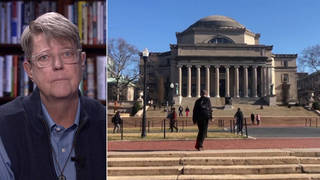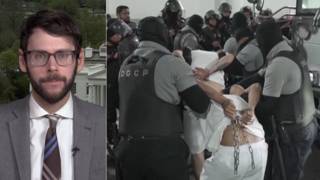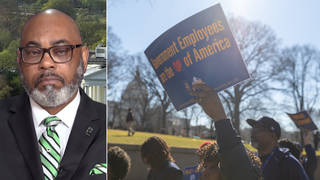
After the Halabja gassing President Bush I and Sen. Bob Dole fought sanctions against Iraq even though the gassing killed thousands and was reportedly carried out in part by U.S.-made helicopters. From 1989 to 1990 the gassing was mentioned about once a month in major press outlets, yet in the three weeks leading up to the 2003 invasion, the press mentioned it 150 times. In 15 years the gassing went from an untold story to a pretext for invasion. [Includes transcript]
Click here to read to full transcript As the occupation of Iraq drags on, U.S. forces have yet to find any weapons of mass destruction in Iraq. Weapons of mass destruction were cited to the public as well as Congress as the primary reason for the invasion.
In the months leading up to the war and since the overthrow of Saddam Hussein, the accusation that Iraq has used chemical weapons against its citizens has been stated with greater frequency by the administration. The piece of hard evidence most frequently brought up concerns the gassing of Iraqi Kurds at the town of Halabja in March 1988, near the end of the eight-year Iran-Iraq war. President Bush himself has cited Iraq’s “gassing its own people,” specifically at Halabja, as a reason to topple Saddam Hussein.
In an interview yesterday on ABC’s This Week With George Stephanopolous, Secretary of State Colin Powell said “Halabja is a city in northern Iraq, where, and on a Friday in March of 1988, Saddam Hussein gassed the people with VX, with sarin, nerve agents, and it killed 5,000 people in one day; that was 15 years ago. Now, if you want to believe that he suddenly gave up that weapon and had no further interest in those sorts of weapons, whether it be chemical, biological or nuclear, then I think you’re — it’s a bit naive to believe that.”
Powell also didn’t bother to mention that people connected to the US government at the time of the Halabja massacre believe Iran, not Iraq, committed the atrocity.
In January of this year former CIA senior political analyst on Iraq during the Iran-Iraq war Stephen C. Pelletiere wrote in the The New York Times “We cannot say with any certainty that Iraqi chemical weapons killed the Kurds.”
Furthermore, both the Reagan and Bush administrations authorized the sale to Iraq of various items that had both military and civilian applications, i.e., chemical and biological weapons.
In a 1991 Los Angeles Times piece about U.S. ties to Iraq, Henry Weinstein writes, “In 1982, the Reagan administration excused Iraq from the list of international terrorists that had been a barrier to virtually all trade Baghdad…First on Hussein’s shopping list was helicopters — he bought 60 Hughes helicopters and trainers with little notice. However, a second order of 10 twin-engine Bell “Huey” helicopter, like those used to carry combat troops in Vietnam, prompted congressional opposition in August, 1983.”
Weinstein continues: “In 1988, Kurdish civilians were attacked with poisonous gas from Iraqi helicopters and planes. U.S. intelligence sources say they believe that the American-built helicopters were among those dropping the deadly bombs.”
- John Stauber, co-author of the new book Weapons of Mass Deception. He is the founder and executive director of the Center for Media & Democracy which publishes the news magazine PR Watch.
- Stephen Pelletiere, former senior CIA political analyst on Iraq. Pelletiere was privy to much of the classified material having to do with the Persian Gulf and he headed a investigation in 1991 into how the Iraqis would fight a war against the United States. The classified version of the report went into great detail on the Halabja affair.
TRANSCRIPT
AMY GOODMAN: Well, you can stay with us as we move on to our next subject, which is the issue of weapons of mass destruction. And now, hearing both general Colin Powell yesterday on “this week with George Stephanopoulos” on ABC, and Condoleezza Rice, both on CNN. And in this example, this clip from Fox news, as they tried to distance themselves from the issue of weapons of mass destruction being found now in Iraq. They’re going back in time. This is Condoleezza rice.
[TAPE]
CONDOLEEZZA RICE: The president took a very bold and decisive action. Everybody knows that the world is much better off with Saddam Hussein gone. Nobody wants to argue that we would have been better off to leave him in place. Given that this brutal dictator is gone, this man who used weapons of mass destruction in really one of the great crimes against humanity in this century.
AMY GOODMAN:So there we have it. Condoleezza Rice talking about the example of Halubjah.
Now, let’s talk about Halubjah, March of 1988. And what exactly happened there. We’re joined out phone, in addition to Ray Mcgovern, by another C.I.A. analyst for a number of years, Steven Pelletiere, as well as John Stauber. He’s the co-author of Weapons of Mass Deception. We’re going back in time now, we’re going back 15 years. John Stauber, you to a very interesting chronology in your book of what happened after the people of Halubjah were gassed. Can you describe the incident and then tell us in terms of what U.S. bush administration, the first bush, said.
JOHN STAUBER: Well, Amy, let me first start by saying that even I have been absolutely stunned by the statements of Colin Powell and Condoleezza rice, especially the secretary of state who went to Halubjah recently and said the U.S. should have acted sooner there because of what occurred there, which is the gassing of thousands of men, women, and men. And here is the ultimate hypocrisy. I think this has become the primary justification now for the war. But the event occurred in 1988. The chemicals were supplied by the Reagan administration. And after the gassing of civilians in Halubjah, there was a bipartisan effort to try to pass the 1988 prevention of genocide act. That act was killed by Colin Powell, who was Ronald Reagan’s secretary of — or was Ronald Reagan’s national security advisor, and he led the effort to kill the prevention of genocide act introduced after Halubjah. I mean, chemical Ali, who we’re hearing so much about, was essentially our ally during that time. And if history were truthfully told, we would probably be referring to Colin Powell as chemical Colin. Now, what happened after Halubjah, of course, just a couple years later, Saddam Hussein apparently thought he was so well loved by what was then the bush administration succeeding the Reagan administration that, of course, he invaded Kuwait, took over those oil fields, and soon learned that the bush administration would not allow that. In order to galvanize U.S. support for a war against our former ally, Saddam Hussein, the bush administration working with a front group funded by the Kuwaiti royal family called citizens for a free Kuwait staged a stunt in October of 1990, a hearing before the congressional human rights caucus, at which they were investigating Iraqi atrocities. Well, there were plenty of Iraqi atrocities, such as the most stunning atrocity, the gassing at Halabjah. But rather than refer to events in which the U.S. Reagan administration was complicit, they concocted a phony atrocity, and that, of course, was the “Nayirah Testimony” where this tearful young girl said she saw Iraqi soldiers rip babies out of incubators and leave them to die in occupied Kuwait. That was probably the turning point. That testimony, which was repeated over and over on the news was probably the turning point in the U.S. Senate voting to support the first gulf war. Of course, it came out a year later, although I think most Americans still do not know this, that that testimony was completely false, that anonymous young girl was actually a member of the Kuwaiti royal family. Her family, the Kuwaiti ambassador to the U.S., was in the room. A Llyod Fitz-Pegado Vice President of the Hill & Knowlton, which received over $10 million from Kuwaitis, to set up the front group, coached that young girl in her false testimony. And it’s very interesting, as we wrote, I wrote “weapons of mass deception” to go back and look at how the first gulf war, there was almost no mention of Halabjah because, of course, there was no desire on the part of the bush administration to draw attention to a genocidal event in which they had been complicit. Instead, in order to demonize Saddam Hussein, the former bush ally, they repeated over and over the baby killing charge, the phony charge. Now flash ahead to the current situation and what we see is that the true story that this was a staged and phony event is not in the news.
What’s in the news today and has become sort of the primary argument for a wider war was a good thing is Halabjah. And the real crank up for publicizing Halabjah began in September of 2002, just as the current bush administration was doing its so-called product launch for the war in Iraq. Now, we’ve gone back and actually analyzed very carefully the number of reportings both in the Halabjah with the search program.
And I won’t spit out the statistics stinks, they’re in our book, but they ignored Halabjah in which the U.S. was complicit, provided the weapons of mass destruction, and then Colin Powell led the lobby campaign to kill the prevention of genocide act. More recently, I think they’ve got the American public duped and confused into thinking that Halabjah was some sort of recent event because they are now repeating the Halabjah story over and over, and it’s been echoed over and over in the news since September 2002. But bottom line here, if chemical Ali goes on trial, I think probably chemical Colin should be on trial with him.
AMY GOODMAN: Well It t sounds like they would not be the only ones on trial in a just world, if Halabjah is the example being used for the killing of innocent civilians. When we come back, I’d like you to actually give the numbers of the times Halabjah was raised right after it happened through the gulf war, and then how often it has been raised now. But what about that trip in 1990 that senator Alfonse D’Amato took — rather, senator Robert Dole took? Alfonse D’Amato was raising this issue early on. But senator Robert Dole went with four other senators to meet with Saddam Hussein in northern Iraq, and they fought to prevent sanctions from being applied to Saddam Hussein. This was after Halubjah. It was senator Robert dole, then senator-Alan Simpson of Wyoming, senator Frank Murkowski of Alaska, and senator Howard Metzenbaum of Ohio. Stay with us.
[MUSIC BREAK]
AMY GOODMAN: You’re listening to Democracy Now!, the war and peace report. I’m Amy Goodman. As we talk about Halabjah. We’re talking about Halabjah because that is being used more and more-being raised- as the reason the U.S. invaded Iraq. No, not in 1988 when the Kurds were gassed in Halabjah, not in 1989, not in 1990 or 1991 when the U.S. bombed Iraq. But being used now in 2003. Secretary of state Colin Powell went to Iraq in the last few weeks, and he visited the site of the mass graves in a museum dedicated to the 5,000 people who lost their lives in the 1988 chemical attack. A reminder, he said, of why the United States went to war to oust Saddam Hussein’s regime. John Stauber is the author of Weapons of Mass Deception: the uses of propaganda in Bush’s war on Iraq.”
We’re also joined by Steven Pelletiere, who is a former C.I.A. analyst who was in charge of Iraq years ago at the time of the Halabjah gassing, as well as Ray McGovern’ remaining on the line with us, a longtime C.I.A. analyst for more than a quarter of a century under the director of central intelligence George Bush and also when George Bush was Vice President was one of his daily briefers. But, I just wanted to get those numbers John of how often in that Nexis Lexis search how often Halabjah was raised after the actual gassing, the Persian gulf war, and now.
JOHN STAUBER: During the buildup to “Operation Desert Storm”, and I’m just reading right out of our work here in “Weapons of Mass Deception,” the first Bush administration avoided mentioning the Halabja incident didn’t mention it, reporters seldom mentioned it either. The search of the Lexis Nexis news database shows that Halabjah was mentioned in 188 news stories in the U.S. in 1988, the year it occurred. It was rarely mentioned, however, in subsequent years. 20 stories in 1989, and only 29 in 1990, the year that Saddam invaded Kuwait. Between the invasion of Kuwait on August 2, 1990 and the end of operation desert storm on February 27, 1991, Halabjah received only 39 mentions. And during the entire following decade, it barely averaged 16 mentions per year. During the presidential election year of 2000, Halabjah got 10 mentions. The story didn’t really begin to circulate again in the U.S. media until September 2002 when the George W. Bush administration began its public push for war with Iraq. After that, mentions began to increase sharply. The Halabjah incident was mentioned 57 times in the month of February 2003 alone.
In March, the month the war began, it was mentioned 145 times. By then, nearly 15 years had passed, memories had faded, and it was safe to talk about Saddam’s gassing of Iraqi citizens. Only a few of the journalists who wrote about Halabjah in 2002 and this year bothered to mention that Saddam committed his worst atrocities while the president’s father was showering him with financial aid. So there you have it.
Now Halabjah is probably one of the few foreign words pronounceable by most people in the U.S., but I suspect if a survey were done, they would tell you that, indeed, this must have been a recent occurrence, not something that took place 15 years ago with the complicity and collusion and cover-up by Colin Powell and the Reagan administration.
AMY GOODMAN: Let’s bring Steven Pelletiere into this conversation. You were working at the C.I.A. at the time of the Halabjah gassing, is that right?
STEPHEN PELLETIERE: That’s right.
AMY GOODMAN: And can you tell us what you understood at the time happened there? You’ve raised some very serious questions.
STEPHEN PELLETIERE: Yeah, I can tell you, and it’s not just that I was working at the agency at the time. It’s that after I left the agency to become senior professor at the war college, I was passed by the army to specifically investigate Halabjah. With all due respect to your guest, Stauber, in my opinion, he’s got it wrong. We know the circumstances under which the alleged attack took place. It was a battle. The Iranians had infiltrated the town and were attempting to take it over so they could use it as a staging ground to perpetuate — to perpetrate an invasion into Iraq. The Iraqi commander ordered the use of chemical weapons in order to drive the Iranians out of the town. Those chemicals were delivered by mortar shells. Chemical Ali had nothing to do with this operation. That was a decision of the Iraqi commander on the spot, and he took that decision because it was essential to regain the town. Now, the Kurds that were killed, and it’s an unfortunate expression, collateral damage. The Iraqis were not aiming at the Kurds, they were aiming at the Iranians. And there was a report done by the D.I.A. at the time, which also investigated it, in which the D.I.A. determined because of the condition of the bodies that the Kurds had been killed by Iranian gas, not by Iraqi gas. And they determined this because the extremities were blue, and that indicated a cyanide-based gas, and the Iraqis didn’t have it.
Finally, the journalists who appeared on the spot and investigated it and took those awful pictures which everyone has seen, never counted more than a few score of bodies, and the original stories, and you can go back and look at the Christian Science Monitor and other reports of what went on by reporters in the town, all uniformly saying a couple of hundred people killed, now that’s been swollen to the point where we’re now claiming between 3,000 and 5,000.
Now, the problem here is that there seems to be an attempt by and it’s unfortunate, because it seems to be coming mostly from the peace community — to characterize Halabjah as an instance of Washington’s duplicity because they supported Iraq, and therefore, didn’t mention the atrocity when it occurred. But then later on, when they went to war with Iraq, they dug it up. The implication is that, in fact, it was an atrocity all along. It’s quite true that the administration has attempted to exploit Halabjah to bring, to take the United States to war, and that’s dreadful. That’s a lie. Because, in fact, the circumstances surrounding Halabjah had been completely distorted.
AMY GOODMAN: I’m looking at a series of pieces that Henry Weinstein of the Los Angeles Times did way back in 1991 about the vehicles that were used to, among other things, perhaps deliver that gas attack. And it says in 1982, the Reagan administration excused Iraq from the list of international terrorists that had been a barrier to virtually all trade with Baghdad. The next year, the U.S. began providing agricultural credits to allow Iraq to buy American rice and grain. In 1984, former diplomatic relations were restored for the first time in 17 years. Let’s remember, when they were restored, they were restored when Reagan-Bush envoy Donald Rumsfeld went to Saddam Hussein in Iraq, shook his hand, and even when they knew at the time that he had been using chemical weapons, in a U.N. report, as well as a state department report, they normalized relations. In 1985, that was my insert, going back to Henry Weinstein’s piece, in 1985, U.S. companies were invited to the first Iraq-sponsored business exhibition in Baghdad. Trade between U.S. firms in Iraq began as soon as Baghdad escaped the terrorist list. First on Hussein’s shopping list was helicopters. He bought 60 Hughes helicopters and trainers with little notice. However, a second order of 10 twin-engine Bell “Huey” helicopters like those used to carry combat troops in Vietnam, prompted congressional opposition in August 1983. Congressman Berman complained in a letter to Secretary of State George P. Shultz that it had been a “serious mistake to take Iraq off the terrorism list” and warned that “American helicopters will fuel the Iran-Iraq conflict.” Nonetheless, the sale was approved. Hussein was still buying helicopters in 1984 when Berman again urged Schulz to intervene. This time Iraq sought 45 Bell 214ST helicopters that originally were designed for military purposes. U.S. officials said Iraq proposed using some of them to fury V.I.P.’s and equip others for crop-dusting. It then went on to say that the procedural changes in Washington came after the helicopter sales were completed. In 1988, Kurdish civilians were attacked with poisonous gas that were Iraqi helicopters and planes. U.S. intelligence sources say they believe that the American-built helicopters were among those dropping the deadly bombs. While officials in the U.S. were debating the wisdom of helicopter sales to Iraq, Hussein was undertaking a massive global weapons oppositions program of far greater consequence. Your comment on that, Steven Pelletiere.
STEPHEN PELLETIERE: My comment on that is this —- put it into context. What was the American position when the Iran-Iraq war broke out? We obviously were against Khomeini and obviously against Iran. First of all, we’d just gone through the hostage ordeal. But beyond that, what was the aim of Khomeini? The aim of Khomeini was to exploit the Iranian revolution to Iraq and into the Saudi peninsula and into Kuwait. He was appealing,to Shias and the Shias are extensive all through Iraq, Kuwait, into Saudi Arabia, to rise up and revolt against their governments. At that time, those governments were supplying us with oil. It was not in our interest to see Khomeini take over Saudi Arabia. We sent Steven Solarz, then out to Iraq -—
AMY GOODMAN: Then Congressman of New York —
STEPHEN PELLETIERE: To Baghdad in 1983, and Solarz met with Saddam Hussein, and Saddam Hussein agreed that he would discontinue all of his activities with various terrorists organizations.
AMY GOODMAN: I wanted to bring John Stauber back into this conversation, because I know what Steven Pelletiere is putting forward is quite controversial. John?
JOHN STAUBER: It is controversial. I do want to respond to it. You know, Steven wrote an op Ed in the “New York Times” on January 31 where I think most people first became aware of this argument titled “the war crime or an act of war”. And that precipitated a letter from Kenneth Roth, the executive director of Human Rights Watch, who took sharp disagreement to what Steven has said and how he’s portrayed Halabjah and I’ll just quote briefly —
STEPHEN PELLETIERE: But also, Kenneth Roth before the war advocated our going to war with Iraq.
AMY GOODMAN: Let -
STEPHEN PELLETIERE: And Human Rights Watch now has a team out there looking for mass graves, and as far as I’m aware, they haven’t found them. That is mass graves specifically associated with these alleged attacks on the Kurds.
AMY GOODMAN: Let John Stauber finish his point.
JOHN STAUBER: Thank you, Amy. I think it would be very useful to probably further examine this having Steven on with someone from Human Rights Watch. But the Human Rights Watch position is this — Human Rights Watch, researchers and I’m quoting from their letter interviewed survivors from Halabjah and reviewed 18 tons of Iraqi state documents to establish beyond doubt that the attack was carried out by Iraq. Iraqi forces used mustard and nerve gas, as well as mass executions to kill some 100,000 Kurds in the genocidal 1988 campaign.
STEPHEN PELLETIERE: I can speak to each one of those claims
AMY GOODMAN: Well, we’re going to continue this discussion, because we’ve come to the end of this program, but we will do it very soon. I want to thank you all for being with us.
STEPHEN PELLETIERE: Oh, my God, Amy, you’re cutting me off?
AMY GOODMAN: I am because the show is ending. We’ll have you back. I want to thank you for being with us, Steven Pelletiere, John Stauber, and Ray Mcgovern. Please go to our web site for more information at democracynow.org. This is clearly an issue that needs further investigation. You can get a copy of today’s show by calling 800-881-2359. You can also sign up for our daily digest at democracynow.org.











Media Options